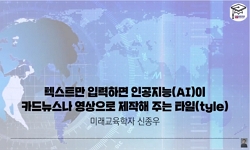이 연구의 목적은 소통 현상이나 텍스트(담화)에 대한 언어 지식이 실제의 언어 사용이라는 ‘실용’과 상생할 수 있는 문법 교수-학습에 대한 패러다임을 정립하고, 구체적인 방법을 마련...
http://chineseinput.net/에서 pinyin(병음)방식으로 중국어를 변환할 수 있습니다.
변환된 중국어를 복사하여 사용하시면 됩니다.
- 中文 을 입력하시려면 zhongwen을 입력하시고 space를누르시면됩니다.
- 北京 을 입력하시려면 beijing을 입력하시고 space를 누르시면 됩니다.
통합적 소통을 위한 문법교육의 교수-학습 방법 연구 : 국어 문법교육과 한국어 문법교육의 접점 찾기를 통하여 = A Study on the grammar education teaching-learning Methods for integrated communication:Through finding the contact point of the national language grammar education and the Korean language grammar education
한글로보기부가정보
국문 초록 (Abstract)
이를 위해 본 연구에서는 한국어의 구조와 특징을 체계적으로 연구하고 정립한 국어교육의 문법 교수-학습과 의사소통의 맥락과 언어 사용 능력 향상을 중시한 한국어교육의 문법 교수-학습이라는 두 인접 학문의 접점 찾기를 시도해 보았다. 이에 따라 ‘삶의 지평’을 접점의 종속 변인으로, ‘통합적 소통’을 접점의 독립 변인으로 설정하여 통합적 소통을 위해 필요한 문법능력을 ‘의사소통 현상에서 화자와 청자의 역동적 되먹임이 정확하고 적합하게 이루어지도록 도와주는 언어문화 적응 및 내면화를 위한 기저 능력’으로 재개념화하였다. 그리고 재개념화한 문법능력의 발현을 위한 문법 교수-학습 연구를 위해 국어교육과 한국어교육의 문법 교육과정 내용 및 문법 교육과정의 교수-학습 설계 양상, 교수-학습 방법 등을 비교하고 분석하였다.
이를 바탕으로 소통의 기저 지식 및 삶과 연관된 문법능력, 화자와 청자의 역동적인 되먹임, 언어문화 적응 및 내면화를 위한 기저 능력, 텍스트 중심의 문법 탐구 역량 등을 강화하기 위한 국어교육 문법 교수-학습 모형을 한국어교육의 문법 교수-학습 보완 모형을 변형·적용하고 최근 국어 문법교육의 성과를 첨가하여 구안하였다. 이렇게 제안한 ‘통합적 소통을 위한 문법교육의 교수-학습 모형’은 교수-학습의 단계를 ‘제시(Presentation)–시범(Modeling)–연습(Practice)-통합(Integration)-평가(Evaluation)’의 5단계로 나누었다. 각 단계 중 ‘제시’, ‘시범’, ‘연습’ 단계는 텍스트와 관련된 문법 지식 탐구를 중심으로, ‘통합’ 단계는 이전 단계에서 탐구한 문법 지식을 바탕으로 학습자의 삶의 지평을 넓힐 수 있는 활동을 중심으로 이루어지게 된다.
문법 교수-학습은 ‘교사 및 학습자’, ‘교수-학습 맥락’과 ‘평가’, 그리고 ‘텍스트’가 상호 융합되어 문법 교실의 활력을 추동하도록 해야 하고, 교수-학습이라는 전체 시스템 안에서 여러 교수-학습 변인의 섭동을 유발해야 한다. 따라서 본고에서 미진하게나마 시도했던 텍스트와 학습자의 삶이 역동적으로 소통하는 통합적 소통을 위한 문법교육에 대한 천착과 연구가 마중물이 되어 ‘지금-여기’의 국어교육에서 좀 더 발전적인 논의가 이루어지기를 기대해 본다.
이 연구의 목적은 소통 현상이나 텍스트(담화)에 대한 언어 지식이 실제의 언어 사용이라는 ‘실용’과 상생할 수 있는 문법 교수-학습에 대한 패러다임을 정립하고, 구체적인 방법을 마련하는 것이다. ‘문장’ 차원의 자료를 중심으로 문법 요소의 천착에 주된 관심을 기울였던 기존 국어교육의 문법 교수-학습은 이제 ‘텍스트’를 중심으로 한 의사소통의 기저 능력 향상에 대한 고민으로 시선을 돌려야 한다. 그리고 문법적 지식 그 자체에만 머물러 있지 않고, 학습자의 ‘삶’과 밀접하게 관련되어 있어야 하며, 더 나아가 학습자의 ‘자율성’을 촉진하고, 삶의 지평을 넓힐 수 있어야 한다.
이를 위해 본 연구에서는 한국어의 구조와 특징을 체계적으로 연구하고 정립한 국어교육의 문법 교수-학습과 의사소통의 맥락과 언어 사용 능력 향상을 중시한 한국어교육의 문법 교수-학습이라는 두 인접 학문의 접점 찾기를 시도해 보았다. 이에 따라 ‘삶의 지평’을 접점의 종속 변인으로, ‘통합적 소통’을 접점의 독립 변인으로 설정하여 통합적 소통을 위해 필요한 문법능력을 ‘의사소통 현상에서 화자와 청자의 역동적 되먹임이 정확하고 적합하게 이루어지도록 도와주는 언어문화 적응 및 내면화를 위한 기저 능력’으로 재개념화하였다. 그리고 재개념화한 문법능력의 발현을 위한 문법 교수-학습 연구를 위해 국어교육과 한국어교육의 문법 교육과정 내용 및 문법 교육과정의 교수-학습 설계 양상, 교수-학습 방법 등을 비교하고 분석하였다.
이를 바탕으로 소통의 기저 지식 및 삶과 연관된 문법능력, 화자와 청자의 역동적인 되먹임, 언어문화 적응 및 내면화를 위한 기저 능력, 텍스트 중심의 문법 탐구 역량 등을 강화하기 위한 국어교육 문법 교수-학습 모형을 한국어교육의 문법 교수-학습 보완 모형을 변형·적용하고 최근 국어 문법교육의 성과를 첨가하여 구안하였다. 이렇게 제안한 ‘통합적 소통을 위한 문법교육의 교수-학습 모형’은 교수-학습의 단계를 ‘제시(Presentation)–시범(Modeling)–연습(Practice)-통합(Integration)-평가(Evaluation)’의 5단계로 나누었다. 각 단계 중 ‘제시’, ‘시범’, ‘연습’ 단계는 텍스트와 관련된 문법 지식 탐구를 중심으로, ‘통합’ 단계는 이전 단계에서 탐구한 문법 지식을 바탕으로 학습자의 삶의 지평을 넓힐 수 있는 활동을 중심으로 이루어지게 된다.
문법 교수-학습은 ‘교사 및 학습자’, ‘교수-학습 맥락’과 ‘평가’, 그리고 ‘텍스트’가 상호 융합되어 문법 교실의 활력을 추동하도록 해야 하고, 교수-학습이라는 전체 시스템 안에서 여러 교수-학습 변인의 섭동을 유발해야 한다. 따라서 본고에서 미진하게나마 시도했던 텍스트와 학습자의 삶이 역동적으로 소통하는 통합적 소통을 위한 문법교육에 대한 천착과 연구가 마중물이 되어 ‘지금-여기’의 국어교육에서 좀 더 발전적인 논의가 이루어지기를 기대해 본다.
다국어 초록 (Multilingual Abstract)
In this context, this thesis attempted to find the contact point of the two adjacent disciplines of the teaching-learning of national language grammar education which studies systematically the structure and characteristics of the Korean language and the grammar teaching-learning of Korean language education that emphasizes the context of communication and the enhancement of language use ability. Accordingly, the “horizon of life” was set as the dependent variable and the “integrated communication” as the independent variable, and the grammatical ability needed for integrated communication was reconceptualized as “the adaptability of language culture that helps the dynamic feedback of the speaker and the hearer to be done accurately and suitably. And for the grammar teaching-learning research to develop the reconceptualized grammar ability, the contents of grammar curriculums, the teaching-learning design aspects of grammar curriculums, and teaching-learning methods, etc. of national language education and Korean language education were compared and analyzed.
Based on this, by transforming and applying the Korean language education grammar teaching-learning supplementary model, the national language education grammar teaching-learning model to reinforce the basic knowledge of communication, life-related grammar ability, dynamic feedback of the speaker and the hearer, adaptability to language culture, and text-oriented grammar inquiry capabilities was designed. The teaching-learning stages of “the grammar education teaching-learning model for integrated communication” proposed in this way was divided into 5 stages: presentation, modeling, practice, integration, and evaluation. Of these stages, the “presentation,” “modeling,” and “practice” stages center on the inquiry into grammar knowledge related to texts, and the “integration” stage center on the activities that can expand the horizons of the learners’ lives based on the grammar knowledge explored in the previous stages.
The grammar teaching-learning should give an impetus to the vitalization of grammar class through mutual integration of “teacher & learners” and “teaching-learning contexts” and “evaluation” and “texts,” and should lead to perturbation of various teaching-learning variables within the overall system of teaching-learning. Accordingly, I expect that delving into, and research on, the grammar education for integrated communication where texts communicate with the learners’ lives dynamically which this thesis attempted to explore with much to be desired will become priming water to develop more expansive discussions from the “here and now” national language education.
The purpose of this research is to establish the paradigm of grammar teaching-learning in which communication phenomena or linguistic knowledge of texts (discourse) can be compatible with “practicality” of actual use of language and to prepare its...
The purpose of this research is to establish the paradigm of grammar teaching-learning in which communication phenomena or linguistic knowledge of texts (discourse) can be compatible with “practicality” of actual use of language and to prepare its concrete methods. The existing grammar teaching-learning of national language education which emphasizes delving into grammatical elements centering on the data in terms of “sentence” should focus on the emphasizing the enhancement of the basic communication ability centering on “texts.” And it should not stay in grammatical knowledge itself but should be closely connected with the learners’ “lives,” and by extension, it should promote “autonomy” of the learners and broaden the horizons of their lives.
In this context, this thesis attempted to find the contact point of the two adjacent disciplines of the teaching-learning of national language grammar education which studies systematically the structure and characteristics of the Korean language and the grammar teaching-learning of Korean language education that emphasizes the context of communication and the enhancement of language use ability. Accordingly, the “horizon of life” was set as the dependent variable and the “integrated communication” as the independent variable, and the grammatical ability needed for integrated communication was reconceptualized as “the adaptability of language culture that helps the dynamic feedback of the speaker and the hearer to be done accurately and suitably. And for the grammar teaching-learning research to develop the reconceptualized grammar ability, the contents of grammar curriculums, the teaching-learning design aspects of grammar curriculums, and teaching-learning methods, etc. of national language education and Korean language education were compared and analyzed.
Based on this, by transforming and applying the Korean language education grammar teaching-learning supplementary model, the national language education grammar teaching-learning model to reinforce the basic knowledge of communication, life-related grammar ability, dynamic feedback of the speaker and the hearer, adaptability to language culture, and text-oriented grammar inquiry capabilities was designed. The teaching-learning stages of “the grammar education teaching-learning model for integrated communication” proposed in this way was divided into 5 stages: presentation, modeling, practice, integration, and evaluation. Of these stages, the “presentation,” “modeling,” and “practice” stages center on the inquiry into grammar knowledge related to texts, and the “integration” stage center on the activities that can expand the horizons of the learners’ lives based on the grammar knowledge explored in the previous stages.
The grammar teaching-learning should give an impetus to the vitalization of grammar class through mutual integration of “teacher & learners” and “teaching-learning contexts” and “evaluation” and “texts,” and should lead to perturbation of various teaching-learning variables within the overall system of teaching-learning. Accordingly, I expect that delving into, and research on, the grammar education for integrated communication where texts communicate with the learners’ lives dynamically which this thesis attempted to explore with much to be desired will become priming water to develop more expansive discussions from the “here and now” national language education.
목차 (Table of Contents)
- 제1장 서 론 1
- 1. 연구의 목적과 필요성 1
- 2. 선행 연구 검토와 연구 방법 6
- 제2장 문법 능력과 문법 교수-학습의 지향 13
- 1. 문법교육이 지향하는 문법 능력의 재개념화 13
- 제1장 서 론 1
- 1. 연구의 목적과 필요성 1
- 2. 선행 연구 검토와 연구 방법 6
- 제2장 문법 능력과 문법 교수-학습의 지향 13
- 1. 문법교육이 지향하는 문법 능력의 재개념화 13
- 2. 문법 능력 발현을 위한 문법 교수-학습 23
- 제3장 문법교육 내용과 교수-학습 설계의 비교 고찰
- 1. 국어교육과 한국어교육의 문법교육 내용 30
- 가. 국어교육의 문법교육 내용 30
- 1) 공통 교육과정의 문법 영역 내용 체계 32
- 2) 선택 교육과정의 문법 영역 내용 체계 38
- 3) ‘지금-여기’ 문법교육 내용의 문제점 분석 42
- 나. 한국어교육의 문법교육 내용 및 범주 45
- 1) 한국어 교육과정의 문법 영역 내용 체계 및 내용 45
- 2) 외국인을 위한 한국어 문법 영역의 내용 체계 및 내용 50
- 2. 문법 교육과정의 교수-학습 설계 양상 55
- 가. 국어 문법교육의 교수-학습 설계 양상 56
- 나. 한국어 문법교육의 교수-학습 설계 양상 62
- 제4장 통합적 소통을 위한 문법교육의 교수-학습 방법 67
- 1. 기존 국어교육 문법교육의 교수-학습 방법 67
- 가. 문법 교수-학습의 방향 67
- 나. 탐구 학습을 중심으로 한 문법 교수-학습 모형 68
- 다. 독서연극을 통한 이야기 활용 문법 교수-학습 방법 71
- 라. 협력학습을 중심으로 생태학적 관점의 통합 문법 교수-학습 방법 74
- 2. 한국어교육 문법 교수-학습이 국어 문법교육에 주는 시사점 77
- 가. 한국어교육의 문법 교수-학습 방법 77
- 나. 한국어 문법교육이 국어 문법교육에 주는 시사점 84
- 3. 통합적 소통을 위한 문법 교수-학습 모형 87
- 4. 통합적 소통을 위한 문법 교수-학습의 실제 96
- 제5장 결 론 106
- 1. 연구의 요약 106
- 2. 연구의 한계와 전망 및 국어 문법교육에 대한 제언 108
- [연구자료] 114
- [참고문헌] 114
- [ABSTRACT] 119












